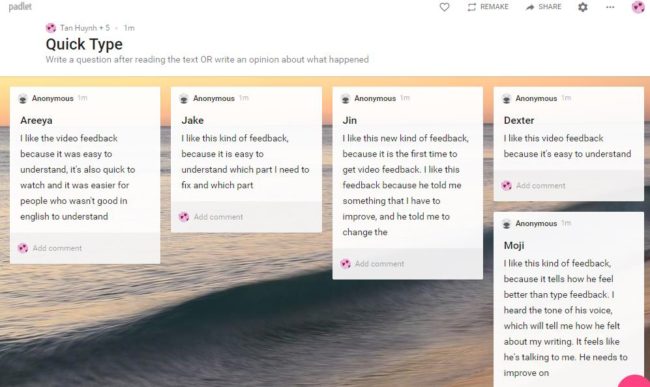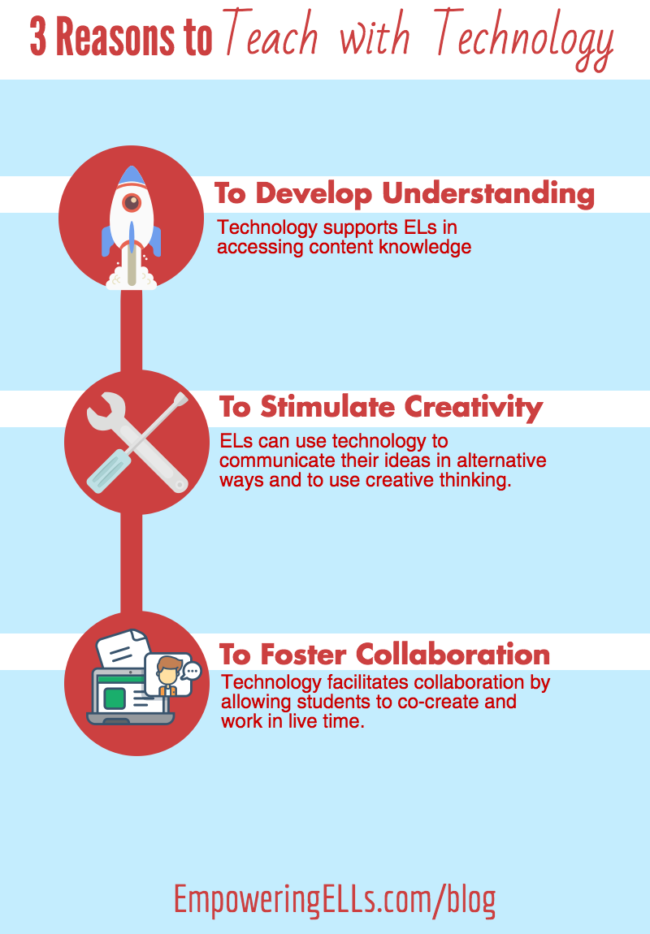Part 1 of the Transforming Instruction Through Technology series.
When I first started teaching, the extent of my technology use consisted of projecting work, planning instruction on a laptop, and using USB drive. Try not to be too impressed.
I used only the limited technology that was provided by my school and was just as slow to integrate it when I moved to a much more tech-forward international school with a 1:1 laptop ratio.
When I finally started developing instructional goals for technology, I realized that there has been a dramatic shift in the philosophy of technology usage. We have moved beyond an Industrial-Era approach where students are passive consumers of information to a modern one where students become: prosumerlators – those who produce content, consumer content, and collaborate over content.
Our duty is to prepare ELs for their future, not our past. Tech fosters critical thinking, spurs creativity, and cultivates collaboration – all skills needed for their futures.
So why exactly should teachers be integrating more technology in their classrooms?
Much of my understanding of how to meaningfully integrate technology within an EL context comes from Heather Parris, Lisa Estrada, and Andrea Honigsfeld’s book entitled ELL Frontiers: Using Technology to Enhance Instruction for English learners (2016). I consider this book THE guide to strategic technology integration for ELs.
1. Tech Develops Understanding
Technology presents abstract information through a combination of images, audio, animation, and interactive capabilities, which can help develop ELs’ understanding (Parris, Estrada, & Honigsfeld, 2016). They do not need to have a mastery of a new language to learn new and challenging things.
Offers Flexibility through Translanguaging
In fact, tech invites ELs to learn through what’s called translanguaging, which occurs when multiple languages are used to understand or communicate. When an EL uses Google Translate to understand a word or phrase in Japanese, he is translanguaging. If you assign a Youtube video, students can change the subtitles to display their home language; this is also translanguaging. Because the internet has produced a proliferation of information, teachers can invite students to translanguage by searching for a resource in their home language that is related to the topic of focus.
Promotes Interactive Learning Through Online Simulations
Technology can also develop ELs’ understanding of a concept or topic through online simulations. Mr. Arno, a science teacher, uses this Peppered Moth simulation to teach the concept of natural selection in an interactive way. Please note, however, that having ELs engage with a simulator doesn’t alone ensure ELs are learning content. Teachers also need to reinforce the use of simulators by holding conversations after students have played the online games.
Helps Create More Equal Access to Content
Tech honors ELs’ right to equal access to content by differentiating how ELs construct meaning (Parris, Estrada, & Honigsfeld, 2016). You don’t have to use the tech tools that I suggest, but you do have to “choose the right one to enhance instruction and provide ELs equity and accessibility within the classroom” (Parris, Estrada, & Honigsfeld, 2016, Kindle location 338)
Notice how I selected the word enhance instead of replace. If a tech tool doesn’t enhance education, then it shouldn’t replace what was used previously. The last thing we want is for new bells and whistles to become distractions for learning.
2. Tech Empowers ELs to Create
Technology also allows teachers to differentiate how ELs demonstrate their understanding and create from their content knowledge. One of my greatest struggles used to be getting Entering or Beginning ELs to produce work. It took me years to realize that they couldn’t produce their work because I didn’t differentiate the task using technology.
With technology in hand, I’m now able to offer different tasks for ELs to demonstrate their understanding regardless of their language proficiency. I have students use
- Padlet to post and organize images related to the content,
- Adobe Spark to create animated videos with voiceover, and
- Buncee to create engaging presentations.
I’ll explain each of these tools in future posts.

Before using these tech tools, my students produced almost nothing. Now, they have different ways to show they understand and can use these tools to build on their understanding. Though the final products my Entering and Beginning ELs create might not be the same as my more proficient ELs, I’m still able to assess their understanding and can provide feedback.
Most importantly, tech celebrates whatever language skills ELs can offer and open opportunities for ELs to use language authentically.
3. Tech Fosters Collaboration
Collaboration distinguishes Industrial-Era instruction from modern learning . Just look at the collaboration that occurs with user-based services such as Uber and Airbnb. Uber doesn’t own taxis, but they’re the largest taxi company in the world. And Airbnb doesn’t own real estate, but they produce the most accommodation bookings in the world (MaRae, 2015). The creators behind Uber and Airbnb allow people to collaborate in an access economy through collaboration. Uber and Airbnb provides the platform, and the users collaborate through offering their cars and homes.
We can prepare students for a life of this virtual and in-person collaboration by using software that facilitates group work. As Parris, Estrada, and Honigsfeld write,
“[In a digital learning environment,] teachers move away from traditional direct instruction and become facilitators of a classroom where the delivery of instruction is based on personalized learning, inquiry and research, and positive student engagement” (2016, Kindle location 345).
For myself – I’m a Google Drive fanatic! In all of my classes, I use Google Classroom to share documents and resources. Students collaborate with each other by:
- co-writing paragraphs on Google Docs,
- organizing presentations on Google Slides,
- produce surveys in Google Forms,
- showcase their work in a digital portfolio through Google Sites,
- and manage calendars, events, and tasks using Google Keep.
Because their work is automatically saved in the cloud, students can work remotely on any device and all the Google products sync with one another. The goddess of Google Classroom teaching is a woman by the name of Alice Keeler. I highly recommend reading her book 50 Things Teachers Can Do with Google Classroom.
The most important and understated benefit of using Google Suite for Education (the products previously mentioned) is that it makes learning more student-centered. The teacher becomes the facilitator of the interaction by giving students a context to collaborate. Google Suite is my teaching partner by offering ELs a platform to co-create.
Takeaways
Initially, I really didn’t like using technology because I was turned off by the bells and whistle nature in which some teachers used it. They used new tech tools simply to replace existing learning tools instead of to enhance instruction. However, after adopting these three clear expectations around tech integration, technology has become a positive teaching partner that enhances my EL instruction.
Like Keeler said, “Good T[eacher]s] can’t be replaced by tech. What tech does is allow T[eacher]s to spend more time focusing on their learners & building those relationships” (2014). We integrate technology after we have established strong teaching practices with the hope of developing better relationships with ELs and raising their achievement.
Keeler, A. [alicekeeler]. (2014, Aug 30). Good Ts can’t be replaced by tech. What tech does is allow Ts to spend more time focusing on their learners & building those relationships. [Tweet]. Retrieved from https://twitter.com/alicekeeler/status/505547536996638720
McRae, H. (2015, May 05). Facebook, Airbnb, Uber, and the unstoppable rise of the content non-generators. Retrieved from http://www.independent.co.uk/news/business/comment/hamish-mcrae/facebook-airbnb-uber-and-the-unstoppable-rise-of-the-content-non-generators-10227207.html
Parris, H., Estrada, L., & Honigsfeld, A. M. (2016). ELL frontiers: Using technology to enhance instruction for English learners. Thousand Oaks, CA: Corwin.



